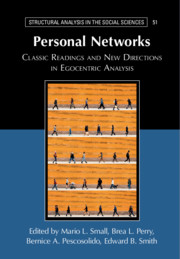Book contents
- Personal Networks
- Structural Analysis in the Social Sciences
- Personal Networks
- Copyright page
- Contents
- Figures
- Tables
- Contributors
- I Background
- II Early Foundations
- III Later Foundations
- 8 From Claude S. Fischer, To Dwell among Friends
- From the Northern California Community Study, 1977–1978, to the University of California, Berkeley, Social Networks Project, 2015–2020
- 9 From Mark S. Granovetter, “The Strength of Weak Ties”
- Strength of Weak Ties in the Labor Market: An Assessment of the State of Research
- 10 From Barry Wellman and Scot Wortley, “Different Strokes from Different Folks”
- A Network Pilgrim’s Progress: Twenty-Six Realizations in Fifty-Five Years
- 11 From James S. Coleman, “Social Capital in the Creation of Human Capital”
- Three Decades of Research into Social Capital: Achievements, Blind Spots, and Future Directions
- 12 From Bernice A. Pescosolido, “Beyond Rational Choice”
- Confronting How People Cope with Crisis: From the Social Organization Strategy Framework to the Network Episode Model to the Network Embedded Symbiome
- 13 From Scott L. Feld, “The Focused Organization of Social Ties”
- Reflections on “The Focused Organization of Social Ties” and its Implications for Bonding and Bridging
- 14 From Ronald S. Burt, Structural Holes
- Structural Holes Capstone, Cautions, and Enthusiasms
- 15 From Edward O. Laumann, Peter V. Marsden, and David Prensky, “The Boundary Specification Problem in Network Analysis”
- On the Boundary Specification Problem in Network Analysis: An Update and Extension to Personal Social Networks
- 16 From Miller McPherson, Lynn Smith-Lovin, and James M. Cook, “Birds of a Feather”
- The Enormous Flock of Homophily Researchers: Assessing and Promoting a Research Agenda
- 17 From Robert Huckfeldt and John Sprague, “Networks in Context”
- Individuals, Groups, and Networks: Implications for the Study and Practice of Democratic Politics
- 18 From Nan Lin, “Building a Network Theory of Social Capital”
- Social Capital: An Update
- 19 On the General Social Survey
- IV New Perspectives
- Index
- Recent Books in the Series
- References
Structural Holes Capstone, Cautions, and Enthusiasms
from III - Later Foundations
Published online by Cambridge University Press: 01 October 2021
- Personal Networks
- Structural Analysis in the Social Sciences
- Personal Networks
- Copyright page
- Contents
- Figures
- Tables
- Contributors
- I Background
- II Early Foundations
- III Later Foundations
- 8 From Claude S. Fischer, To Dwell among Friends
- From the Northern California Community Study, 1977–1978, to the University of California, Berkeley, Social Networks Project, 2015–2020
- 9 From Mark S. Granovetter, “The Strength of Weak Ties”
- Strength of Weak Ties in the Labor Market: An Assessment of the State of Research
- 10 From Barry Wellman and Scot Wortley, “Different Strokes from Different Folks”
- A Network Pilgrim’s Progress: Twenty-Six Realizations in Fifty-Five Years
- 11 From James S. Coleman, “Social Capital in the Creation of Human Capital”
- Three Decades of Research into Social Capital: Achievements, Blind Spots, and Future Directions
- 12 From Bernice A. Pescosolido, “Beyond Rational Choice”
- Confronting How People Cope with Crisis: From the Social Organization Strategy Framework to the Network Episode Model to the Network Embedded Symbiome
- 13 From Scott L. Feld, “The Focused Organization of Social Ties”
- Reflections on “The Focused Organization of Social Ties” and its Implications for Bonding and Bridging
- 14 From Ronald S. Burt, Structural Holes
- Structural Holes Capstone, Cautions, and Enthusiasms
- 15 From Edward O. Laumann, Peter V. Marsden, and David Prensky, “The Boundary Specification Problem in Network Analysis”
- On the Boundary Specification Problem in Network Analysis: An Update and Extension to Personal Social Networks
- 16 From Miller McPherson, Lynn Smith-Lovin, and James M. Cook, “Birds of a Feather”
- The Enormous Flock of Homophily Researchers: Assessing and Promoting a Research Agenda
- 17 From Robert Huckfeldt and John Sprague, “Networks in Context”
- Individuals, Groups, and Networks: Implications for the Study and Practice of Democratic Politics
- 18 From Nan Lin, “Building a Network Theory of Social Capital”
- Social Capital: An Update
- 19 On the General Social Survey
- IV New Perspectives
- Index
- Recent Books in the Series
- References
Summary
Adjunct to the preceding excerpt from Structural Holes, this chapter’s goal is to provide a capstone summarizing where we are on Structural Holes’ subject of network brokerage, and my cautions and enthusiasms concerning directions in which things are going. I focus on core ideas and results rather than on literature.1 In the capstone, I discuss the information breadth, timing, and arbitrage advantages of network brokers, and returns to those advantages contingent on a broker’s social standing. Research linking network structure with success has been a first generation of work.
- Type
- Chapter
- Information
- Personal NetworksClassic Readings and New Directions in Egocentric Analysis, pp. 384 - 416Publisher: Cambridge University PressPrint publication year: 2021
References
- 12
- Cited by



